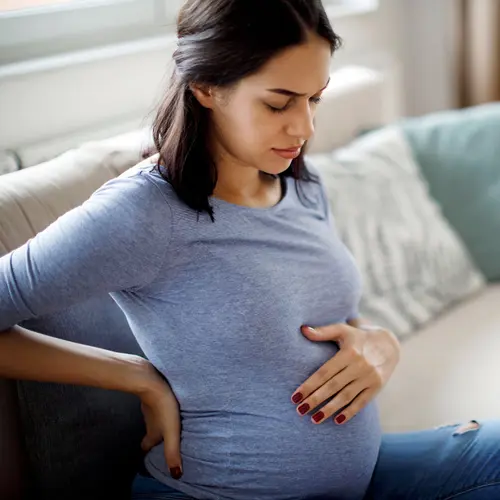PUPPP stands for pruritic urticarial papules and plaques of pregnancy. Also known as polymorphic eruption of pregnancy (PEP), it is one of the most common types of rash you can get during pregnancy.
Though harmless, it does cause an itchy rash with hive-like bumps on your belly and stretch marks during your third trimester. It can spread to other parts of your body, including your back, breasts, arms, and buttocks.
A PUPPP rash usually goes away on its own and doesn’t cause any scarring or lasting skin color changes.
PUPPP Rash Cause
Experts don’t know what causes a PUPPP rash, but it might be linked to stretch marks. One theory is that if your skin stretches too quickly around your belly, your cells can’t keep up. The underlying tissue becomes damaged, which exposes proteins that cause a quasi-allergic reaction. The result is a rash near your stretch marks.
A PUPPP rash is more common in twin or triplet pregnancies. That’s because when you carry more than one baby, you typically gain a lot of weight faster and your skin expands quickly. A rash is also common in first-time pregnancies when your skin hasn’t stretched the same way before.
Some research suggests that the presence of fetal DNA in your skin (which usually happens in the third trimester) could be the cause, but it’s still unclear what causes a PUPPP rash.
The rash usually goes away on its own after your baby is born. You rarely get it again during another pregnancy, which suggests you might build immunity to it. It might also be linked to high levels of progesterone hormone during pregnancy, but there are no clear causes.
PUPPP Rash Symptoms
PUPPP rashes that occur during pregnancy often feel like hives. The rash starts with itching on your belly, especially your stretch marks. A few bumps appear, which spread and form a large rash. The rash looks like a mix of hives, raised lumps, small blisters, and a large, red, inflamed area across your belly.
Other PUPPP rash symptoms include:
- A yellow discharge from blisters when you scratch
- A crust over the skin
- Severe itching that interferes with daily activities
- Widespread markings across your arms, breasts, thighs, butt
A PUPPP rash rarely affects your face, feet, or hands.
PUPPP Rash Diagnosis
There is no test for a PUPPP rash. Your doctor will can usually diagnose it by looking at your skin and talking about your symptoms.
If the rash looks unusual, your doctor might order tests to rule out other conditions. Tests may include:
- Skin scrapings
- Complete blood count
- Liver function tests
- Cortisol test
- Metabolic panel
Sometimes, a PUPPP rash looks like another skin condition called pemphigoid gestationis (PG). Both conditions cause a rash in your last trimester, though PG can show up earlier. PG is rare but can cause serious side effects for your baby.
To rule out PG, your doctor might take a sample of your skin to do a test called immunofluorescence. However, in most cases, your doctor can tell you have a PUPPP rash just by looking at it.
PUPPP Rash Treatment
A PUPPP rash usually goes away within three to four weeks of you delivering your baby. The condition doesn’t harm you or your baby, so you usually don’t need medical treatment. However, most people need relief from the intense itching. You can typically treat these symptoms at home.
Personal care
Take cool baths or showers to soothe your skin and use fragrance-free bodywash. A soothing oatmeal cleanser is a good option. You can also add colloidal oatmeal to a bath and soak for 10-15 minutes, which may ease itching.
After your shower, moisturize your skin with a fragrance-free lotion or ointment for itchy skin. Petroleum jelly can also help soothe very itchy skin and may work better than a cream. Then, wear loose-fitting, cotton clothes.
Home remedies
You can ease swelling and itching with a cool compress. Soak a clean cloth in cool water and apply to the area. Once it gets warm, soak it again and reapply as needed. You can also apply a cooling or soothing moisturizer afterward.
Over-the-counter medications
If personal care and home remedies don’t help, you can use over-the-counter medications from the pharmacy. You should always read the label and check with your doctor to make sure they’re pregnancy-safe.
If your rash only affects a small area, you can apply a hydrocortisone anti-itch cream and take newer antihistamine allergy medication, such as cetirizine or cyproheptadine. Not all antihistamine medications are safe for pregnancy, so make sure you have the correct type.
Prescription medication
Sometimes, a PUPPP rash causes intense itching that may interfere with your daily life. If you have trouble sleeping or feel intense discomfort that leads to exhaustion or other problems, your doctor can prescribe medications. These can include prescription steroid creams to ease inflammation and itching. If the rash is widespread, your doctor might suggest a short course of steroid pills.
Foods to avoid with PUPPP rash
The foods you eat don’t cause PUPPP rash, so there are no specific foods you need to avoid when you have the rash during pregnancy.
Does PUPPP Rash Go Away?
A PUPPP rash is a harmless but itchy and annoying condition that happens during pregnancy. You can often treat it at home with personal care and home remedies, and it eventually gets better on its own. If the symptoms are intense or interfere with your sleep or life, talk to your doctor about other treatments.
PUPPP Rash FAQs
Is PUPPP rash contagious?
PUPPP rash might spread on your body, but it is not contagious.
How long does a PUPPP rash last?
A PUPPP rash usually shows up in your third trimester and lasts about four to six weeks. It clears up by itself a few days after you have your baby.


